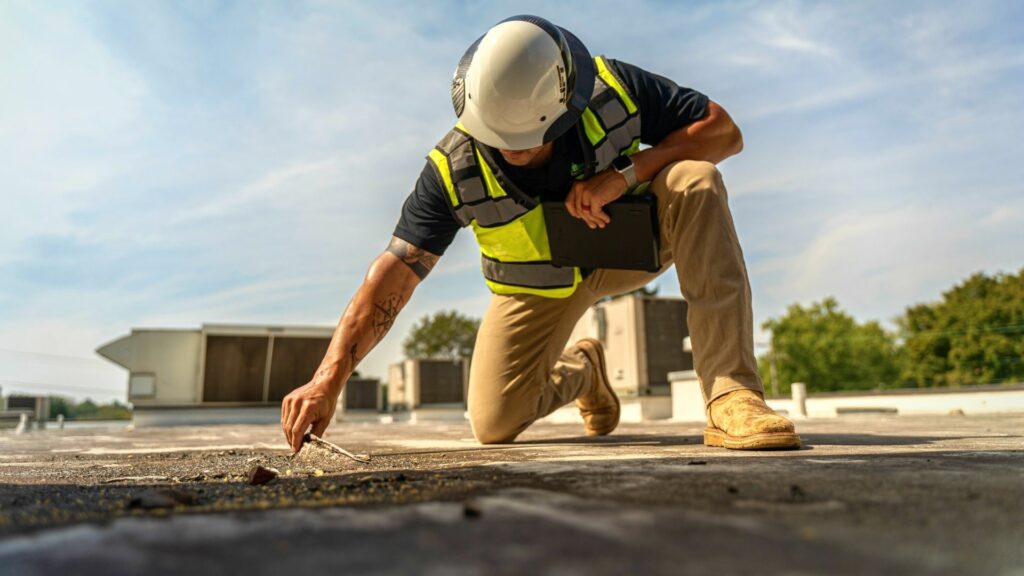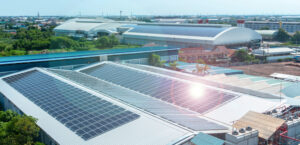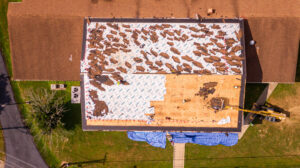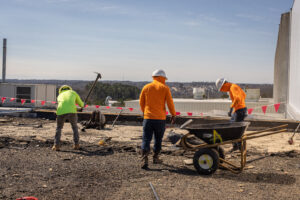In the world of commercial roofing, prioritizing safety is not just important; it’s essential. At Eskola Roofing, our commitment extends beyond merely meeting safety standards – we aim to exceed them. Our approach is deeply rooted in a thorough understanding of the risks associated with commercial roofing and actively mitigating them. Join us as we explore the key strategies we employ in all our commercial roofing projects to ensure roofing is not only effective but also a safe endeavor for everyone involved.
Prioritizing Safety in Commercial Roofing

In the critical field of commercial roofing, Eskola Roofing champions a culture where safety is paramount. Our approach integrates rigorous training, state-of-the-art safety equipment, and regular safety audits, ensuring every team member is not only well-prepared but also equipped with the best tools for their protection. We foster a work environment where open communication about safety is encouraged, allowing for proactive identification and resolution of potential hazards. This holistic commitment to safety, embedded in every aspect of our operations, establishes us as a leader in delivering safe and successful commercial roofing projects.
Safety Protocols in Roof Maintenance
Ensuring Worker Safety
Worker safety is paramount during roof maintenance. This includes:
Proper Training
- Comprehensive Training: All personnel must receive thorough training in roof safety and the specific systems they will be working on. This training should cover the use and care of equipment, hazard recognition, and emergency procedures.
- OSHA Compliance: Training must comply with Occupational Safety and Health Administration (OSHA) standards, ensuring workers are aware of their rights and the safety regulations applicable to their work environment.
- Continuous Education: Regular updates and refresher courses are necessary to keep workers informed about new safety protocols and equipment.
Use of Adequate Safety Equipment
- Personal Protective Equipment (PPE): Workers should always wear appropriate PPE, including hard hats, safety glasses, gloves, and non-slip footwear.
- Fall Protection Systems: Utilize guardrails, safety nets, personal fall arrest systems, and other fall protection equipment, especially when working on surfaces 6 feet or higher above a lower level.
- Tool Safety: Ensure all power tools have safety devices to prevent accidental discharge and that workers wear eye and hearing protection when using them.
Regular Safety Audits
- Worksite Evaluations: Conduct regular safety audits to ensure compliance with safety standards and protocols. These audits should assess the condition of equipment, the effectiveness of safety measures, and adherence to safety practices.
- Hazard Identification: Regularly inspect the worksite for potential hazards, such as unstable surfaces, unprotected roof edges, or hazardous weather conditions.
- Feedback and Improvement: Encourage workers to report safety concerns and use their feedback to improve safety measures.
Additional Safety Considerations
- Permanent Perimeter Flag Lines and Safety Rails: Install bright flag lines and safety rails around the perimeter of the roof to alert workers to edge boundaries and prevent falls.
- Safe Access: Ensure safe and OSHA-compliant access to the roof, particularly with ladders and scaffolds. Fixed access ladders are crucial for safe movement to and from the roof.
- Roof Hatch Rails: Install barriers around roof hatches as a preventative measure against falls.
- Hydration and Heat Stress Prevention: Provide ample water and educate workers on recognizing signs of heat exhaustion, especially during work in hot conditions.
- Equipment Training: Train workers on the proper use, inspection, and maintenance of all equipment, including heavy machinery. Ensure crane operators and other equipment handlers are certified and understand OSHA regulations.
- Communication Protocols: Establish clear communication protocols and ensure all workers understand them. This includes understanding crane signals, forklift operation rules, and emergency procedures.
Roofing Safety Checklist
- Access and Egress: Are the access points to the roof safe and in good repair?
- Material Transportation: How will materials be transported to the roof safely?
- Edge Protection: Are there any open sides or unprotected edges? Are guardrails up to code?
- Walkways and Obstructions: Are walkways clear and visible? Are there any obstructions or hazards on the roof?
- Equipment Safety: Are all roofers equipped with the proper safety equipment for their specific tasks?
- Training and Awareness: Has every roofer been provided with adequate training and understanding of their equipment and job duties?
Ensuring worker safety in commercial roof maintenance is a multifaceted approach that requires diligent training, appropriate use of safety equipment, regular safety audits, and a strong emphasis on communication and hazard awareness. By adhering to these protocols, roofing companies can significantly reduce the risk of accidents and injuries, creating a safer work environment for everyone involved.
Choosing the Right Roofing Contractor

The choice of a roofing contractor is a critical decision for any commercial building project. A reputable roofing contractor brings a wealth of experience and expertise, ensuring not only the quality of the roofing work but also the safety of everyone involved. Key aspects to consider when choosing a contractor include:
- Experience and Expertise: Look for a contractor with a proven track record in commercial roofing. They should understand the complexities of different roofing systems and be committed to following industry-standard safety protocols.
- Certification and Training: A reputable contractor will have a team that is well-trained and certified, particularly in safety practices. This training should be ongoing to keep up with the latest safety standards and techniques.
- Commitment to Safety: The contractor should have a strong safety culture, prioritizing the well-being of their workers and clients. This includes regular safety training, the use of proper safety equipment, and adherence to OSHA guidelines.
Maintenance and Emergency Preparedness
Emergency Response Plans: It’s essential to have a clear and well-communicated plan for responding to roofing emergencies. This includes procedures for securing the roof and the building in the event of high winds or other extreme weather conditions.
Regular Maintenance Checks: Conducting regular maintenance checks is key to ensuring that the roof can withstand harsh weather. This includes inspecting and repairing any damage that could be exacerbated by high winds.
Training in Emergency Protocols: Maintenance teams should be trained in emergency response protocols. This training ensures that they can act quickly and effectively to mitigate damage and ensure safety in emergency situations.
The Impact of Weather and Environmental Factors
Adapting to Climate Conditions
Different climates pose different challenges for roofing systems. In areas with heavy snowfall, for instance, roofs must be regularly cleared to prevent overload. In hot climates, UV protection and thermal regulation are key considerations.
Addressing Environmental Concerns
Environmental factors such as pollution, tree overgrowth, and wildlife can affect roof integrity. Regular inspections can help identify and mitigate these issues.
The risks associated with commercial roofing highlight the critical need for stringent safety measures. At Eskola Roofing, we prioritize safety above all, understanding that it is the foundation of quality and professionalism in the roofing industry.
This guide aims to empower property owners, managers, and roofing professionals with essential safety practices for commercial roof maintenance. A well-maintained roof is a symbol of safety and longevity. We encourage a continued focus on safety, adherence to standards, and collaboration with partners who share these values. Together, we can enhance safety and set new standards in the roofing industry.






